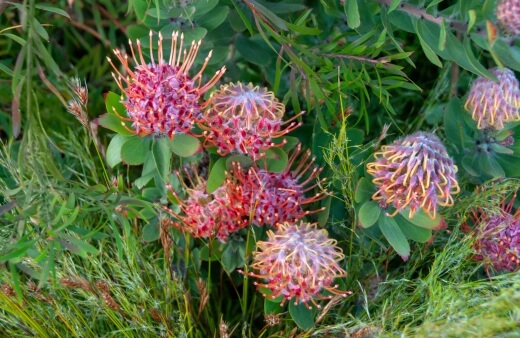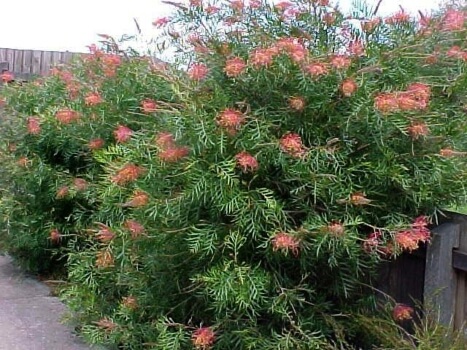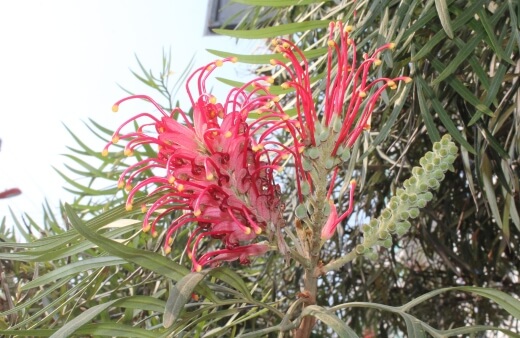Grevillea banksii is a popular cultivar used across Australia and is often one of the parent plants to create other Grevillea hybrids. The more common ones using Grevillea banksii as a parent include Misty Pink, Pink Surprise, and Robyn Gordon.
This type of Grevillea has an impressive size and likes to spread out, up to about 3 metres. Grevillea banksii is more likely to be found in a local Australian garden than growing out in the wild.
More...

Family: | Proteaceae |
|---|---|
Genus: | Grevillea |
Species: | G. banksii |
Common Names: | Byfield waratah, Red Silky Oak, Banks' grevillea |
Origin: | Queensland, Australia |
Location: | Outdoor |
Type: | Shrub/small tree |
Growth: | Up to 8 metres tall and 3 metres wide |
Sun requirements: | Full sun/part shade |
Foliage Colour: | Green/silver |
Flower Colour: | Dark red/shades of pink depending on variety |
Flowering: | Spring, summer |
Fruit: | Flat and hairy follicle containing 2 seeds, usually orange or yellow |
Maintenance level: | Low |
Poisonous for pets: | No |
Grevillea banksii Plant Features
This lovely shrub has silver green leaves and big clusters of flowers which are usually a deep red colour. You can expect flowers around the springtime but flowers can often appear throughout the year which is a delightful surprise.
Grevillea banksii is versatile, adaptable, and useful in many settings. The flowers it produces attract plenty of birdlife, the shrub is ideal to create a hedge but also to stabilise soil on a slope. The shrub also performs well when living in coastal soil. Banks' grevillea does not like a strong frost or too much fertiliser.
How to Grow Grevillea banksii
Grevillea banksii is known for being hardy and enjoys a warm climate. If you can offer it a well-draining soil and full sun, it will be happy. If you are living in the warmer parts of Australia, Banks' grevillea should do well in your garden.
It won’t cope well in very cold areas. If you are living in a colder area, you could grow the plant in a pot and then move it inside during the winter time.

Source: Plants Whitsunday
Propagating Grevillea banksii
It is possible to propagate your own Grevillea banksii using seed. Once you have collected the seeds from an existing plant, you can remove the seed coat using a sharp knife to peel it off.
By doing this, it allows water to get to the seed embryo. You can then sow your seeds in an appropriate growing mixture. Germination takes around 2 weeks.
Caring for Red Silky Oak
- Sunlight - You can grow your plant in either full sun or partial shade. Grevillea banksii does love the sun. If the climate is very hot, some afternoon shade would be ideal. You can also mulch in summer which keeps the roots cool.
- Soil - Banks' grevillea can handle different kinds of soil. It just needs to be well-draining enough and the soil should never be too moist. The shrub likes a soil that is slightly acidic and be sure to add plenty of leaf matter. Mulching around the roots is also recommended.
- Water - Grevillea banksii needs a moderate amount of water.
- Pruning - We recommend pruning which stimulates and encourages flower growth. After your Grevillea banksii has had a few growing seasons, you can then do some heavy pruning where necessary. Just be sure you don’t disturb the roots of your plant.
- Fertiliser - You can feed your Banks' grevillea using blood and bone or a native fertiliser that has little phosphorus.
Grevillea banksii Pests and Diseases

Grevillea banksii doesn’t struggle much with pests and disease but they can be affected by leaf spot. Cercospora and phyllosticta are two fungal diseases that love humid conditions.
If your grevillea is infected with the Phyllosticta fungus, you would usually notice that the leaves become yellow, and are spotted with grey, black or brown spots. Cercospora fungus causes the leaf colour to change to light brown or a bronze shade and then eventually turn grey.
Often if you look at the leaves up close, you can actually see the fungal spores. If you are dealing with a leaf spot problem on your Grevilla banksii, you can use a fungicide that is made specifically to treat native plants.
Copper based fungicides are a safe and effective way to go. You can also use a regular treatment of neem oil to keep the fungus under control. Do your best to keep water away from the leaves of your Banks' grevillea while it’s being treated.
Grevillea banksii Frequently Asked Auestions
Where does Grevillea banksii get its name from?
Grevillea is after Charles Francis Greville (1749-1809). He was an 18th century patron of botany and also co-founded the Royal Horticultural Society. Banksii was chosen to honour Joseph Banks (1743-1820).
Banks was a botanist and famous traveller who joined Captain Cook on his first circumnavigation from 1768-1771.
Does Grevillea banksii have any special uses in other parts of the world?
G. banksii has become naturalised in some parts of Hawaii, and in the eastern part of Madagascar, the plant is used to help with controlling erosion.
Sign up for our newsletter for more gardening inspiration and advice.
If you are a big fan of grevilleas then be sure to check out our main Grevillea post and discover more of its varieties.
Wrapping Up Our Grevillea banksii Growing Guide
Banks' Grevillea or Red Silky Oak is a much loved Australian native. Whether you display it as a shrub or small tree in your garden, the bright flowers and leaves add vibrancy and colour. As a plant that is known for being hardy, Grevillea banksii requires little work for plenty of reward.
Published on April 2, 2023 by Nathan Schwartz
Last Updated on February 23, 2024




